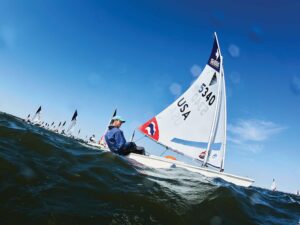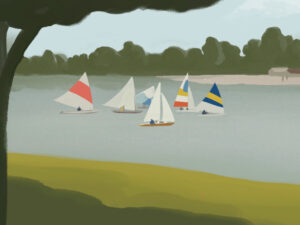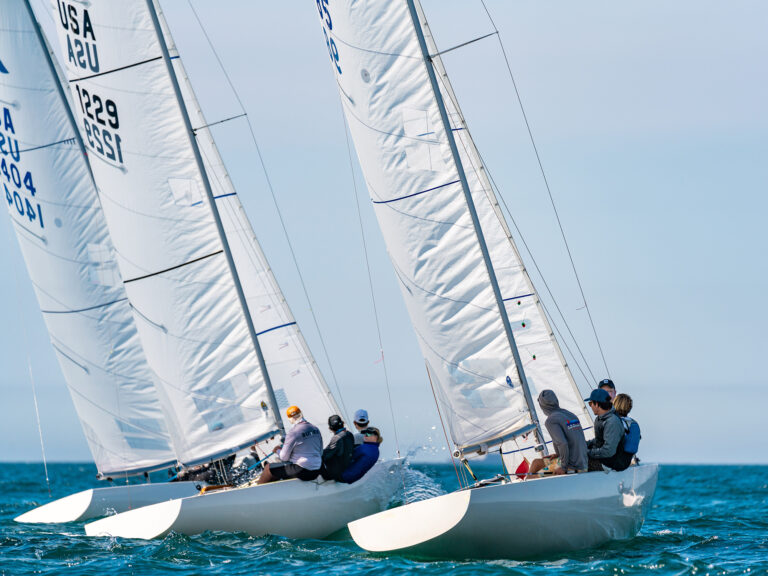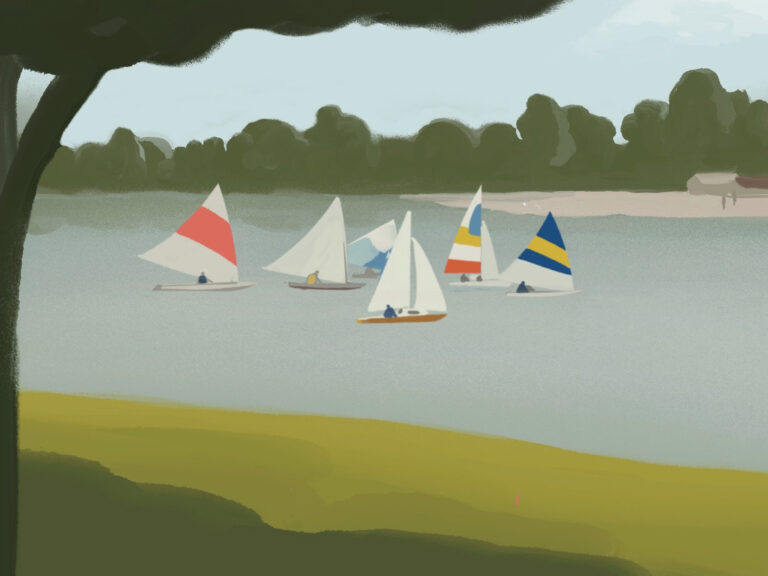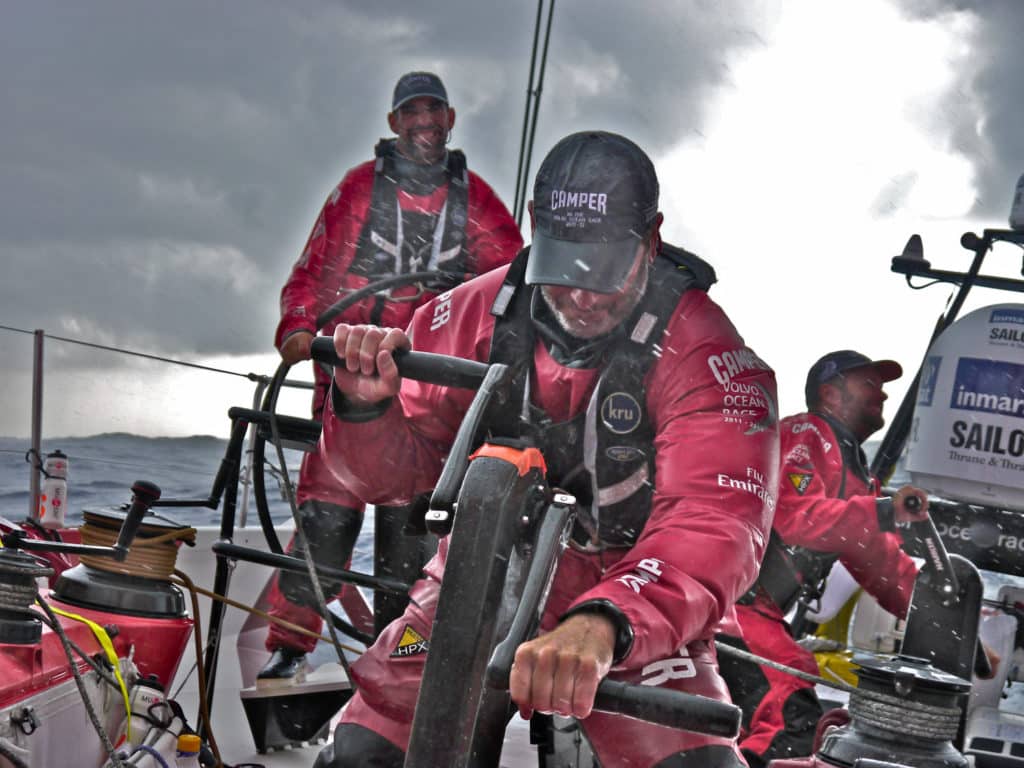
RyanLegThreeFinish960
Ryan O’Grady, a veteran follower of the Volvo Ocean Race and a top amateur sailor, is providing regular insight and analysis on the 2011-’12 Volvo Ocean Race for SailingWorld.com. To get the full picture of this dynamic race, follow the racing in our Finish Line forum, track the fleet, and catch up on the race with O’Grady’s previous Volvo Voyeur blogs.
For NFL fans competing in the Volvo Ocean Race, the finish of Leg 3 had an unexpected benefit. Better than expected wind and sea conditions meant that all of the boats arrived safely in Sanya, China, before the opening kickoff of the Super Bowl. For the New England Patriots fans onboard Puma Ocean Racing—minus New York Football Giants fan and media crewmember Amory Ross, who can now collect a nice dinner from skipper Ken Read—the big game matched their fortunes on water, where bad luck and a questionable call saw mar mostro tumble from the front of the pack to fourth place in the closing stages of the leg.
Unlike the Patriots, whom Vegas oddsmakers are already favoring to win the next Super Bowl, Puma is a long shot to win the race. The odds-on favorite is Team Telefonica, which again won the offshore portion and dominates the leaderboard with a 15-point margin over second-placed CAMPER/ ETNZ. In China, hometown crowds welcomed last-place Team Sanya with a huge celebration.
**1. Can Puma find new life and recover to a winning form?
**To all of the superstitious sailors out there, painting a gigantic leaping black cat on your sails may soon become the equivalent of packing bananas onboard. In each of the offshore legs, Puma Ocean Racing has shown the ability to match the speed of Team Telefonica—before meeting disaster. In the first leg, a fitting failure sent their mast over the side in the midst of a heated duel with Telefonica towards the southern trades. In the second leg, Puma was leading into the Doldrums before finding a windless hole that Telefonica avoided.
Leg 3 saw Puma again in the thick of the action. With the dangers of Malacca Straits—floating debris, heavy shipping traffic, local fishermen—nearly behind them, Puma was within 100 yards of Telefonica and Groupama before the black cat crossed paths with disaster again. Skipper Ken Read recalls the incident: “Imagine this: your shoulder is shaken, and you hear, ‘Wake up, I think we are aground.’ I flew out of bed to jump on deck to see the other two boats moving away from us, and we’re not moving. But there was no crash, no bang. Then Casey says, ‘I think we’re in a fish trap!’ This isn’t good. Sure enough, there’s a small black flag barely visible about 100 yards to the left, and a fishing boat sits about 200 yards to the left of the flag. All were thinking there might be a net attached around the boat and the black flag. Well, once we rolled up the headsail that covers the entire right side of the boat, in the increasing sunlight we see another tiny black flag about a half mile to our right. The two black flags have a net that strings between the two, and we are firmly caught, in really light air and barely maneuverable conditions.”
It took the team the better part of an hour to free themselves of the net, but as Ross explains, that wasn’t the worst of it: “Far worse, while untangling, we sat idle as the dwindling night winds vanished, and we now find ourselves struggling in a windless transition zone while the leaders sail away in the old breeze, and the trailers catch up in the new. It is upsetting.”
Down, but not yet out, Ken Read and navigator Tom Addis faced a crucial decision—stay with the pack and salvage a third, or split and take a shot at the win. “Between Tom and myself, there have always been two ways of approaching this section of the race,” says Read. “Straight ahead and beating up the Vietnam coast to get out of the north to south flowing current, or approaching from the east and spending your “easting” early and getting around the good side of two large tidal eddies that are prominent in the South China Sea. Avoiding the current that runs down the Vietnam coast was the key. We clearly liked the east option.
“What is strange about this sport sometimes is that your fate is given to you, like it or not,” he continues. “Once we tacked to port, we had a fantastic shift, and when we looked at the scheds for the next 15 hours, we kept the left shift that nobody else ever really appeared to get. We had breeze in the 30s, and everyone else was in the high 40s and 50s. In essence, we went where the wind gods took us, and the others did the same thing. And, like Frank Cammas said in Leg 1 when they split from the fleet down the African coast, I was really surprised nobody else came the way we did. Clearly they saw something we didn’t. It didn’t work for us.”
Puma’s bold split ended up costing them the third spot on the podium, but their actions show this is a team that doesn’t yet believe that they’re out of the race. The numbers, however, aren’t as rosy as Read’s resolve. Puma is now 23 points behind third-place Groupama in the standings. The cloud of bad luck needs to change, but the hard part for Puma is going to be finding boats to put between themselves and Groupama. The French have clearly climbed the steep part of the Volvo 70 learning curve and can’t be counted on to make many mistakes. Without any bad luck, the three Juan K boats would’ve occupied the top three spots each leg, so it’s safe to assume that CAMPER and Abu Dhabi won’t be sneaking in between the Juan K boats. Puma will need to beat Groupama boat for boat in five of the remaining six legs. This is certainly possible, but Puma needs luck, and some refinement, to make it happen. As an example, in the last update, we featured a video showing how Telefonica has designed a system to make tacking easier.Here is Puma tacking during Leg 3. More efficient tacking by Telefonica allows them to tack on smaller shifts, and slowly separate. In a close race, details like this are the difference between first and fourth.
**
- Can anyone topple Telefonica?
**The pre-race hype predicted this to be the closest Volvo Ocean Race yet. While it is true that the fleet as a whole is quite close, Telefonica has won every offshore leg and has come from behind in the last two legs to clench victory. Navigator Andrew Cape has yet to make a mistake, and the sailing team always seems to find that extra bit of speed or point when needed most. This was so clearly demonstrated in Leg 3, when Telefonica lost its Code 0 early on. From a last-place position, the team was able to sail in a high, fast mode and go from being the most southern boat to the most northern boat, while catching the pack. Telefonica was then the first team to tack to the new breeze before the Malacca Straits, and they never looked back. The Race Tracker has a feature that lets you rewind and replay legs. Watch the first 1000 miles of Leg 3 to see exactly how Telefonica made their move. It’s a real clinic.
In the long offshore legs, the only boats that have a realistic shot to beat Telefonica are Groupama and Puma, but I think it’s highly likely that Telefonica will win every offshore leg until the fleet gets to Europe. Once in Europe, the legs become short enough that one of the other boats can have a good day and end the Spanish domination. On the long legs, though, Iker Martinez’s team has proven to be able to claw back every time.
**3. Can Team Sanya even finish the race?
**Moose Sanderson had realistic expectations when he entered the only secondhand boat as the final entrant to this race. “Our decision to go for Telefónica Blue in the end was based around the fact that we believe the boat gives us the best chance to be on the podium as often as possible,” he said.
Now, after three consecutive legs with major failures, the team just needs to find a way to get around the course. The latest setback came just 48 hours before the Leg 3 finish, when the port-side winch pod broke. Listen to the sound of carbon splintering when the winch pod breaks.
Once again, the Sanya shore team will be the heroes of the day. “After the work we just did on the bow in Cape Town, this is tiny in comparison,” says shore crew manager David Duff.
Once the team completes repairs, Sanderson hopes they can start working to improve the boat. “Finally we can get the whole thing on track,” he said. “In all the pre-race planning, you do you talk about strategy for stopovers, what you’re going to do with the time, and how you deal with it all. Now we actually get to use that planning, we really get to play our game. We’re here with a strategy and an idea how to get better, so now the wheels can be set in motion.”
We’ll give Team Sanya the benefit of the doubt here. Up until now, it has been a full-on effort just to make it to the starting line of each leg. The leg to Auckland will be the big test. If the boat can’t hold up on Leg 4, how many crewmembers will be willing to take her around Cape Horn?
With one third of this Volvo in the books, the cream is starting to rise to the top. While Telefonica is poised to maintain the tradition of the boat winning the first leg winning the whole race, Iker Martinez and company can’t afford to be complacent. For the chasing pack, second place is still up for grabs, and redemption may be around the corner for some. Leg 4 begins on February 19, and plenty of action still awaits!


